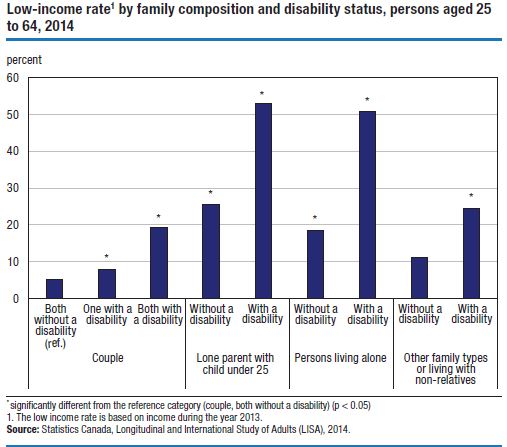The Economics and Statistics Division maintains archives of previous publications for accountability purposes, but makes no updates to keep these documents current with the latest data revisions from Statistics Canada. As a result, information in older documents may not be accurate. Please exercise caution when referring to older documents. For the latest information and historical data, please contact the individual listed to the right.
<--- Return to Archive
For additional information relating to this article, please contact:
August 23, 2017STUDY: LOW INCOME AMONG PERSONS WITH A DISABILITY IN CANADA Statistics Canada released a study last week examining low income rates among persons aged 25 to 64 with a disability in Canada. The study uses data from the 2014 Longitudinal and International Survey of Adults (LISA), as well as data from the 2013 Canadian Income Survey (CIS). The study excludes those living in territories, reserves, other Aboriginal settlements and the institutionalized population.
Low income is measured using the after-tax low income measure, which defines low income as earning less than half the median income, adjusted for household size. Persons with a disability is classified into three mutually exclusive groups: physical - sensory (affecting sight, hearing, mobility, flexibility, dexterity or pain) – 12 per cent of the population; mental-cognitive (affecting mental health, learning, memory or development) – 3 per cent of the population; and combined (affecting both of the above) – 6 per cent of the population.
In 2014, persons with a disability accounted for approximately 20 per cent of Canadian population aged 25 to 64. Among persons with a disability, 23 per cent were in low income, compared with 9 per cent of those without a disability.
Persons with a mental-cognitive disability or combined disabilities were more likely to be in low income than those with a physical-sensory disability. The rate of low income by disability group were: combined disabilities - 35 per cent, mental - cognitive disability - 27 per cent and physical sensory disability - 17 per cent.
Unattached individuals or lone parents with a disability are more likely to live in low income households. Persons with a disability who were unattached individuals aged 45 to 64 or lone parents accounted for 23 per cent of the total low-income population.

Persons with a disability and without a job are at a higher risk of being in the low-income population. Among this population, 4 in 10 lived in low income households, compared with approximately 2 in 10 for persons without a disability.
For unemployed persons without a disability 22 per cent are in low income compared with 35 per cent for those with a physical-sensory disability, 46 per cent for those with a mental-cognitive disability and 47 per cent for those with combined disabilities.
The average employment income for persons with a disability was $29,300 per year compared with $52,200 for those without a disability. Part but not all of this differences in employment income was offset by the fact that persons with disability received $3,100 more in government transfers and paid $5,500 less taxes on average.
Statistics Canada Low Income Study
<--- Return to Archive